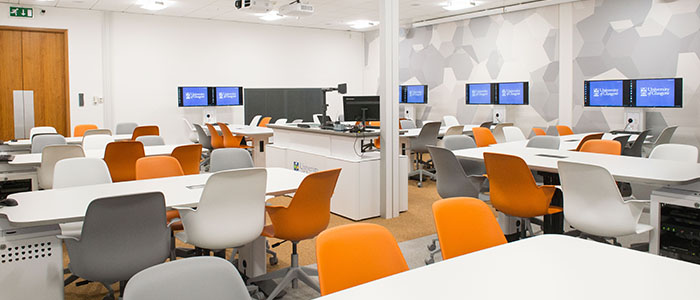Creating spaces for success
Published: 26 October 2018
Programme of works is upgrading teaching spaces across the University
Upon completion, the University’s £90 million the James McCune Smith Learning Hub will set a new standard for the delivery of student-focussed learning support, creating more teaching space and incorporating state of the art facilities.
However, beyond this, the University has also been engaged in a programme of work to upgrade existing learning and teaching spaces, aligning our existing infrastructure, as far as possible, with that available in the new buildings.
So far costing in the region of £7 million, the programme is focussed on delivering flexible, active learning spaces and has upgraded more than 20 spaces including lectures theatres, seminar spaces and flexible-use areas, including new Technology Enhanced Active Learning (TEAL) spaces.

Professor Moira Fischbacher-Smith, Assistant Vice Principal for Learning and Teaching at the University, said: “We have been redesigning a number of the teaching spaces across campus over the last three years. The thinking behind those spaces is that they support active learning so they’re more flexible, we can change the layout depending on what we’re trying to do during that class setting.
“We’ve drawn on international expertise and we’ve drawn on practices that our peer institutions…have been engaging in, and importantly, we’ve been talking to our students and our staff about their experiences here.”
To support delivery of the programme, the University spent time developing a substantial evidence base, which included consulting with experts and studying approaches to learning and teaching in universities around the world.
Closer to home, the University has also been consulting with staff and students to capture the specific needs of building users, with a dedicated working group set up to direct the programme of upgrades.
Lauren McDougall, SRC President, said: “The traditional model of sitting in a lecture and being talked at isn’t necessarily the best way for a lot of people to learn. So much evidence shows that students learn much better when it’s interactive and the design of these spaces encourages that.
“There’s been lots of different consultations, it started with surveys of students to see what they wanted out of the teaching spaces…there’s been workshops on the design of the spaces, the technology of the spaces, even down to the furniture.”

As a first step, a number of trial spaces were upgraded, including teaching rooms in the St Andrew’s , Adam Smith, Gregory and Wolfson Medical School buildings. Whilst feedback from both staff and students has been overwhelmingly positive, this piece of work also highlights further design improvements which will allow us to refine the model going forwards.
In practice, as well as ensuring the more obvious features of a learning space such as IT and AV are fit for purpose, the work also addresses other aspects of the spaces.
Elements such as lighting, power sockets, sound insulation and even the colours used within rooms have been considered to ensure each space is equally accessible, functional and able to adapt to changing learning and teaching models, technological evolution and emerging student needs and interests.
“We’re working really hard to make sure that we give students the best learning experience while they’re here, but also that their learning experience prepares them for the future.” says Professor Fischbacher-Smith.
“This is fundamental to our partnership ethos of working with students - we are co-creating learning spaces as well as co-creating the curriculum.
“The way in which we’re developing these spaces allows us to do that with them in partnership all the way through, and it’s about creating environments where we produce the world changers of the future.”
The University welcomes feedback on any aspect of the newly refurbished teaching spaces. Please direct all comments to
centralspace-feedback@glasgow.ac.uk
First published: 26 October 2018

